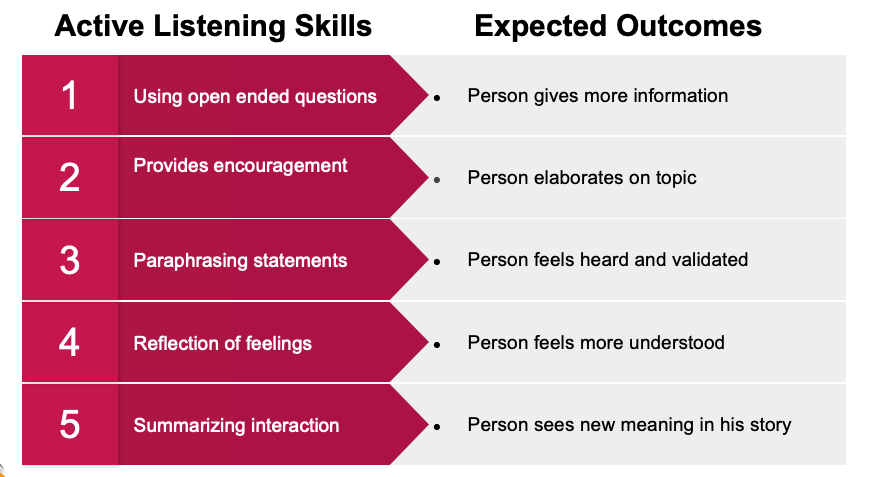
6 Techniques to De-escalate a Threatening Situation
If there is a potentially violent situation at your workplace and you’ve determined that the conditions are safe for de-escalation (see our article “12 Things You’ll Need to Do Before De-escalating a Situation”) you can use the techniques described in the LOWLINE theoretical model (Lowry, 2016). This approach is based on established principles of communication and empathetic listening to help de-escalate difficult and potentially threatening situations.[1]
This model has been used in many contexts and professions from nursing to customer service and involves applying 6 techniques: Listen, Offer, Wait, Look, Incline, Nod, Express= LOWLINE
Listen
When you’re dealing with an angry person it may be tempting to respond quickly but it is important to first listen using active listening skills. Note that you will need to use active listening skills throughout the entire de-escalation process, not just in the beginning.
Active listening isn’t merely hearing the words a person is saying but being able to read:
- Non-verbal signals such as facial expression and body language.
- Paraverbal communication including tone of voice, inflection and volume.
Additionally, active listening involves using non-directive and non-intrusive feedback to let an angry person know you’re paying attention to the person and have interest in what they are experiencing. This means that instead of quickly offering suggestions or explanations, you will allow the person to talk freely. Anything that makes the person to explain instead of arguing can help lower the confrontation level.
Non-directive feedback can include open ended questions or comments such as:
- “Can you tell me more about that?”
- “Please let me understand exactly what happened”.

Image: McMains, M. J., & Mullins, W. C. (2014). Crisis negotiations: Managing critical incidents and hostage situations in law enforcement and corrections. New York: Routledge.
Offer
Offer the angry person the opportunity to vent and explore their feelings. Acknowledge their anger and offer to listen to their concerns. This is not the moment to contradict them or argue but to validate their feelings.
You can say:
“I can see that you’re angry, will you let me help you with your concerns?”.
“I want to work with you, please tell me what’s upsetting you”.
An angry person will not always be able to explain the cause of their anger and you may need to ask them additional questions. For example: “When did you start to feel upset?”

Wait
Don’t be tempted to fill all silences with words. Give the person time to respond.
Count to ten before responding if the situation starts to feel awkward.
Look
Look at the person but make sure not to stare. Continue paying attention to non-verbal cues and facial expressions. Maintain a neutral expression and smile when appropriate.
Incline
Inclining your head or tilting it to the side is a non-verbal sign of interest in what the other person is saying.
Nod
Nodding when appropriate can show maintained interest and willingness to listen without interrupting.
Express
Continue using active listening skills and express empathy and a desire to understand.
- “I can see how that made you feel offended”
- “I understand how that made things worse for you”
- “I can see why you feel that way”
Paraphrasing is another active listening skill, and an effective way of showing empathy and validates the person’s feelings, this involves rewording what the other person has said and summarizing the encounter, pointing the mentioned reasons for the anger:
“You thought that we were meeting at 10:00 instead of 11:00 and you’re angry because you wasted time waiting for me when you’re so busy and on top of that you had to wait in traffic to get here”.
Final steps
After you notice the person has visibly calmed down, explore options on how to resolve the situation. Offer support and advice. You can ask: “What can we do to resolve this?”
Likely there will not be one single solution, so several feasible options should be explored.
Often times, reassurance that the person’s concerns are being taken seriously and not merely being paid lip service to will suffice.
Do’s and Don’ts When Using De-escalation Techniques
- Do intervene early.
- Show genuine concern for the person and adopt a non-authoritarian manner.
- Speak in a calm and gentle voice.
- Be aware of your own body, how you’re looking at the other person and how you’re moving.
- Avoid being passive or indifferent.
- Avoid touching and coming too close to the person.
- Do not show anger or take offense.
- Do not make judgmental comments.
[1] Lowry, M. (2016). De-escalating anger: a new model for practice. Nursing Times. Retrieved from https://www.nursingtimes.net/roles/mental-health-nurses/de-escalating-anger-a-new-model-for-practice/7009471.article
